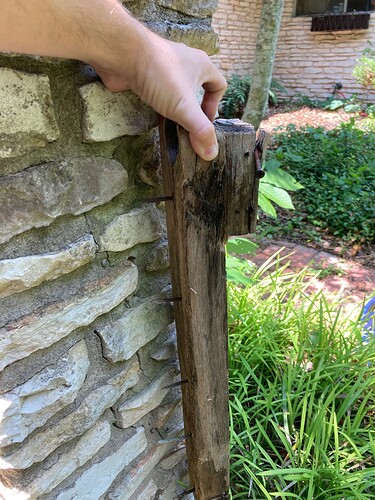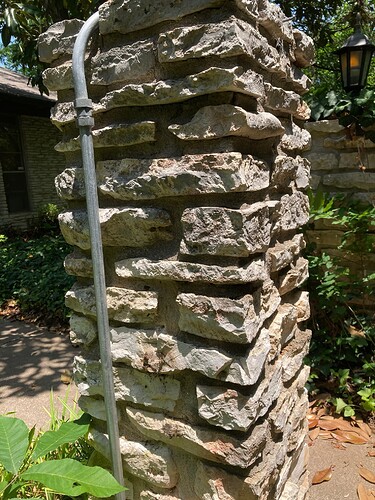We have masonry pillars in our front yard. They used to support wood beams running between them, but the wood has rotted away. We are replacing those beams. The old wood was attached to the pillars with nails that were apparently put in place when the masonry was wet. Obviously, we cannot change the masonry back to wet cement. Our plan is to get masonry screws and a hammer drill to attach the new beams. We’re a bit worried about this because the pillars are small and might crack if there’s too much pounding. Indeed, one of the pillars already has some cracks (see images below).
a) Is this a good plan?
b) If yes to (a), then does anyone have a hammer drill we could borrow?
I have a hammer drill you can borrow. Doesn’t seem that the part is too heavy. I would use a tapcon for this application
We’ve had good success using masonry bits and hardware for similar applications. I think you’ll be ok. i don’t think minor cracks I see in that top photo are indicative of a larger problem. It’s just what happens to mortar over time in my experience
Thanks, Joe.
For tapcons, do you mean something like this?
1/4-in x 2-1/4-in Head Blue Concrete Anchors (8)
https://www.lowes.com/pd/Tapcon-8-Pack-2-1-4-in-x-1-4-in-Concrete-Anchors/3102321
They look sufficient to me, but that’s just intuition — no actual experience… (and yes, what we’re mounting is pretty simple and light decorative fencing — we want it to be sturdy, but no illusions of supporting lots of weight). I do see some TapCon brand stuff getting poor reviews for shearing off, but dunno how realistic that is for this application.
The tapcon you linked is good. People are ignorant or lazy when they are hanging heavy things. If they are hanging something heavy they should use an insert anchor bolt. I assume they went well beyond the sheer rating. Let me know if you need the hammer drill?
Some of our other columns are a bit more cracked, but none of them seem actually unstable. I do expect we’ll be OK on that front. Guess it depends on how much force the hammer drill actually applies… I wonder if it could cause more cracks?
Also need to decide whether to drill into the concrete mortar or the limestone itself. Any experience to offer there?
I feel like every time I’ve done anything involving masonry, I’ve drilled into the mortar, and not the stone/brick. But it’s been ages, and I have a genuinely terrible memory. You might do a trial run on the least visible side down next to the ground? But I’m speculating.
If the mortar is crumbling, there’s a problem. If the sections of rock are moving, there could be a problem. But just some cracks, yet everything is still fairly stable, I wouldn’t worry. Limestone is pretty easy to drill into. A smaller bit, like for Tapcon won’t disturb things too much. If you choose to drill into the mortar it should resist as you drill. If it crumbles as you drill, you may want to stop.
I would be concerned with anything that compresses in on that mortar and stacked limestone. An alternative would be to epoxy or e6000 the fastener into a hole that is the same size as the fastener or slightly larger, so it’s not compressing against the mortar

